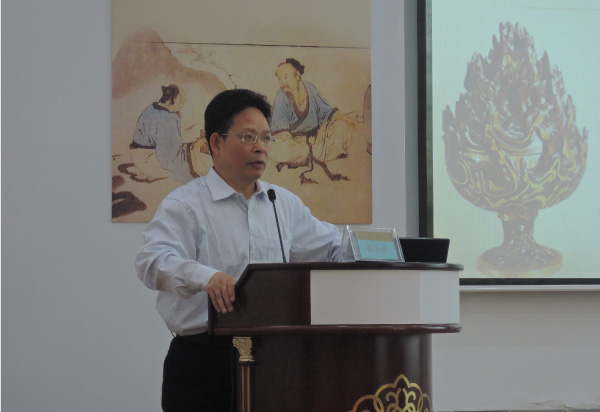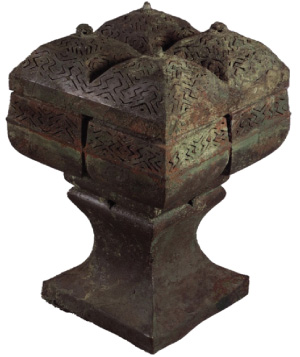NEWS & EVENTS > NEWS
"A nation's culture resides in the hearts and in the soul of its people"
-Mahatma Ghandi
The Vibrancy of Fragrance: Incense Tradition in the Han Dynasty
5 May 2015
Deputy Director of Henan Provincial Institute of Cultural Relics and Archaeology, Liu Hai Wang, presents on the development of incense use in Han Dynasty, China

5 May 2015
Deputy Director of Henan Provincial Institute of Cultural Relics and Archaeology, Liu Hai Wang, presents on the development of incense use in Han Dynasty, China

At the Culture of Incense: Incense Conference held in Nanjing (May 1-2, 2015), Liu Hai Wang, deputy director of Henan Provincial Institute of Cultural Relics and Archaeology, highlighted the richness of Chinese culture that the traditional use of incense displayed. "Looking at the different types of ware used for aromatics and incense in the Han Dynasty, they embodied the vibrancy and colorfulness of Chinese traditional culture. It's necessary to pass on the traditional use of incense to the younger generations."
Mr. Liu began his presentation introducing the different traditional uses of aromatics in the Han Dynasty. The use of aromatics as seasoning, for mortuary burial, to prevent insects and epidemics, were all illustrated with detailed history and related excavated artefacts. An overview of the most frequently discovered aromatics, such as Sichuan pepper, tonka, and lemongrass, from the Han Dynasty were also given.
Different types of incense holders
Helping the audience to more deeply understand the attention paid by the Han Dynasty to cultural activities—a result of economic and social flourishing during the time period—Mr. Liu noted the close relationship between the daily lives of the Chinese people and the difference incense ware that were used. Throughout China's dynastic history, four main types of incense holders were used. While displaying different photos of xiang lu (censers), xiang qiu (a type of spherical container), xiang nong (incense pouch) and xiang chen (incense pillow), Liu encouraged the audience to pay attention to the routines, manners and wisdom shown at that time, as reflected by the design of these receptacles. "Looking closely at the structure of spherical burners, you would easily get inspired by the intelligence of how the ancient Chinese created new things; even at the time when they faced great limitations in technology and techniques", he added. These incense spheres had an outer shell, and inside, a bowl that held the aromatics. Mr. Liu emphasized the genius of the design of this inner half. Through a clever mechanics, this inner bowl was designed to stay horizontally level no matter the movement of the outside sphere, in order to prevent the leak of aromatics. Such a design allowed people to wear the incense sphere on them at any time without worry.
Mr. Liu began his presentation introducing the different traditional uses of aromatics in the Han Dynasty. The use of aromatics as seasoning, for mortuary burial, to prevent insects and epidemics, were all illustrated with detailed history and related excavated artefacts. An overview of the most frequently discovered aromatics, such as Sichuan pepper, tonka, and lemongrass, from the Han Dynasty were also given.
Different types of incense holders
Helping the audience to more deeply understand the attention paid by the Han Dynasty to cultural activities—a result of economic and social flourishing during the time period—Mr. Liu noted the close relationship between the daily lives of the Chinese people and the difference incense ware that were used. Throughout China's dynastic history, four main types of incense holders were used. While displaying different photos of xiang lu (censers), xiang qiu (a type of spherical container), xiang nong (incense pouch) and xiang chen (incense pillow), Liu encouraged the audience to pay attention to the routines, manners and wisdom shown at that time, as reflected by the design of these receptacles. "Looking closely at the structure of spherical burners, you would easily get inspired by the intelligence of how the ancient Chinese created new things; even at the time when they faced great limitations in technology and techniques", he added. These incense spheres had an outer shell, and inside, a bowl that held the aromatics. Mr. Liu emphasized the genius of the design of this inner half. Through a clever mechanics, this inner bowl was designed to stay horizontally level no matter the movement of the outside sphere, in order to prevent the leak of aromatics. Such a design allowed people to wear the incense sphere on them at any time without worry.
Page 1 | 2
Related Links:
ENGLISH TRANSLATION:
"Tang Dynasty Incense archaeological discoveries" transcript
Xin Ge
PRESENTATION SLIDES:
"Tang Dynasty Incense archaeological discovieries"
Xin Ge
ENGLISH TRANSLATION:
"Han Dynasty Insense archaeological discoveries " transcript
Liu Hai Wang
PRESENTATION TRANSCRIPT:
Han Dynasty Incense tradition
5 May 2015
PHOTOS:
Incense Conference 2015
VIDEOS:
Incense Conference 2015
"Tang Dynasty Incense archaeological discoveries" transcript
Xin Ge
PRESENTATION SLIDES:
"Tang Dynasty Incense archaeological discovieries"
Xin Ge
ENGLISH TRANSLATION:
"Han Dynasty Insense archaeological discoveries " transcript
Liu Hai Wang
PRESENTATION TRANSCRIPT:
Han Dynasty Incense tradition
5 May 2015
PHOTOS:
Incense Conference 2015
VIDEOS:
Incense Conference 2015

